HOW TO GRAPH COTANGENT FUNCTIONS WITH TRANSFORMATIONS
Subscribe to our ▶️ YouTube channel 🔴 for the latest videos, updates, and tips.
Subscribe to our ▶️ YouTube channel 🔴 for the latest videos, updates, and tips.
We use the characteristics of the cotangent curve to graph tangent functions of the form y = A cot (Bx- C), where B > 0
Step 1 :
Find two consecutive asymptotes by finding an interval containing one period.
A pair of consecutive asymptotes occurs at
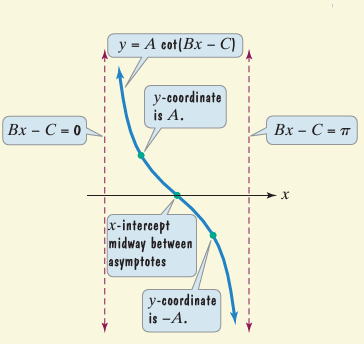
Step 2 :
Identify an x-intercept, midway between the consecutive asymptotes.
Step 3 :
Find the points on the graph 1/4 and 3/4 of the way between the consecutive asymptotes. These points have y-coordinate of A and -A respectively.
Step 4 :
Use the above steps to graph one full period of the function. Add additional cycles to the left or right as needed.
Problem 1 :
Graph y = 3 cot 2x
Solution :
- A = 3, B = 2
- period = 𝜋/|B|
- period for the function y = 3 cot 2x is (0, 𝜋/2)
Step 1 :
Find two consecutive asymptotes, we do this by finding an interval containing one period.
An interval containing one period is (0, 𝜋/2). Thus two consecutive asymptotes occur at x = 0 and x = 𝜋/2.
Step 2 :
Midpoint of x = 0 and x = 𝜋/2 is an x-intercept of the function.
An x-intercept is 0 and the graph passes through (𝜋/4, 0).
Step 3 :
To find the points on the graph which is 1/4 and 3/4 of the way between two consecutive asymptotes, we follow
|
|
|
So, the required points on the curve are (𝜋/8, 3) and (3𝜋/8, -3).
Step 4 :
Vertical asymptote of y = cot x is k𝜋, where k is integer. Here
2x = k𝜋
x = k𝜋/2
- When k = -1, x = -𝜋/2
- When k = 0, x = 0
- When k = 1, x = 𝜋/2
- When k = 2, x = 𝜋
Repeat the same pattern in the interval.
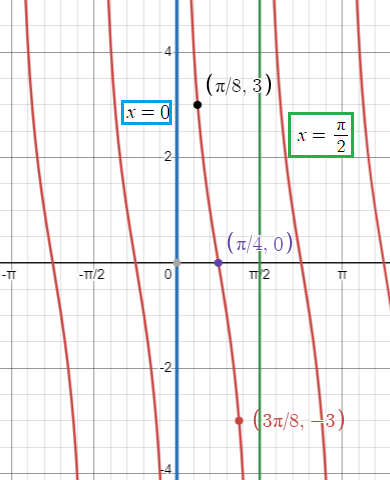
Problem 2 :
Graph y = (1/2) cot 2x
Solution :
- A = 1/2, B = 2
- period = 𝜋/|B|
- period for the function y = (1/2) cot 2x is (0, 𝜋/2)
Step 1 :
Find two consecutive asymptotes, we do this by finding an interval containing one period.
An interval containing one period is (0, 𝜋/2). Thus two consecutive asymptotes occur at x = 0 and x = 𝜋/2.
Step 2 :
Midpoint of x = 0 and x = 𝜋/2 is an x-intercept of the function.
An x-intercept is 0 and the graph passes through (𝜋/4, 0).
Step 3 :
To find the points on the graph which is 1/4 and 3/4 of the way between two consecutive asymptotes, we follow
|
|
|
So, the required points on the curve are (𝜋/8, 0.5) and (3𝜋/8, -0.5).
Step 4 :
Vertical asymptote of y = cot x is k𝜋, where k is integer. Here
2x = k𝜋
x = k𝜋/2
- When k = -1, x = -𝜋/2
- When k = 0, x = 0
- When k = 1, x = 𝜋/2
- When k = 2, x = 𝜋
Repeat the same pattern in the interval.
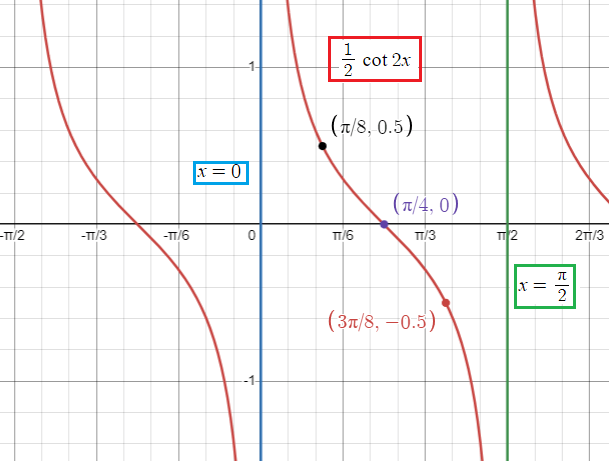
Problem 3 :
Graph y = -3 cot (𝜋/2)x
Solution :
- A = 3, B = 1/2
- period = 𝜋/|B|
- period for the function y = -3 cot (𝜋/2)x is (0, 2)
Step 1 :
Find two consecutive asymptotes, we do this by finding an interval containing one period.
An interval containing one period is (0, 2). Thus two consecutive asymptotes occur at x = 0 and x = 2.
Since there is a reflection, we can draw the graph of y = 3 cot (𝜋/2)x, then using the concept of reflection we can get a new graph.
Step 2 :
Midpoint of x = 0 and x = 2 is an x-intercept of the function.
An x-intercept is 0 and the graph passes through (1, 0).
Step 3 :
To find the points on the graph which is 1/4 and 3/4 of the way between two consecutive asymptotes, we follow
|
|
|
So, the required points on the curve are (0.5, 3) and (1.5, -3).
Using reflection,
(0.5, -3) and (1.5, 3)
Step 4 :
Vertical asymptote of y = cot x is k𝜋, where k is integer. Here
(𝜋/2)x = k𝜋
x = k𝜋/(𝜋/2)
x = 2k
- When k = -1, x = -2
- When k = 0, x = 0
- When k = 1, x = 2
- When k = 2, x = 4
Repeat the same pattern in the interval.
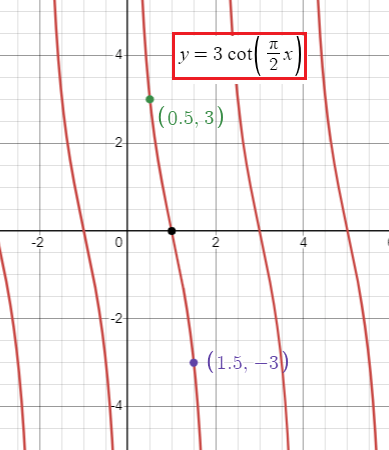
After reflection :
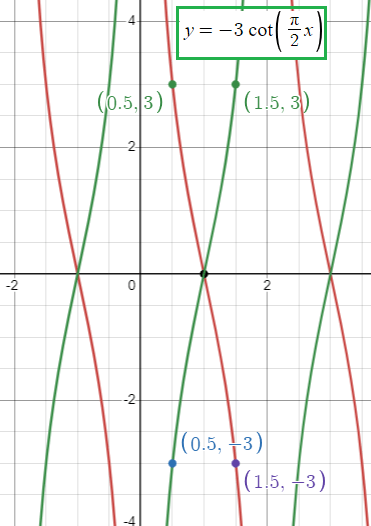
Problem 4 :
Graph y = 3 cot (x + 𝜋/2)
Solution :
- A = 3, B = 1
- period = 𝜋/|B| == > 𝜋
- period for the function y = 3 cot (x + 𝜋/2) is (0, 𝜋)
Step 1 :
Find two consecutive asymptotes, we do this by finding an interval containing one period.
An interval containing one period is (-𝜋/2, 𝜋/2). Thus two consecutive asymptotes occur at x = -𝜋/2 and x = 𝜋/2.
Step 2 :
Midpoint of x = -𝜋/2 and x = 𝜋/2 is an x-intercept of the function.
An x-intercept is 0 and the graph passes through (0, 0).
Step 3 :
To find the points on the graph which is 1/4 and 3/4 of the way between two consecutive asymptotes, we follow
|
|
So, the required points on the curve are (-𝜋/4, 3) and (𝜋/4, -3).
Step 4 :
Vertical asymptote of y = cot x is k𝜋, where k is integer. Here
x+𝜋/2 = k𝜋
x = k𝜋 - (𝜋/2)
x = (2k𝜋 - 𝜋)/2
x = (𝜋/2)(2k-1)
- When k = 0, x = -𝜋/2
- When k = 1, x = 𝜋/2
- When k = 2, x = 3𝜋/2
Repeat the same pattern in the interval.
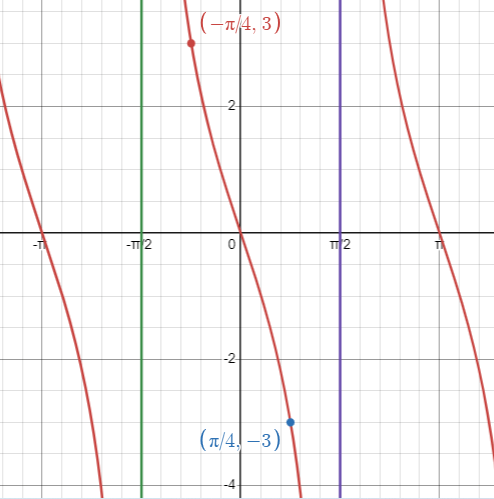
Recent Articles
-
Finding Range of Values Inequality Problems
May 21, 24 08:51 PM
Finding Range of Values Inequality Problems -
Solving Two Step Inequality Word Problems
May 21, 24 08:51 AM
Solving Two Step Inequality Word Problems -
Exponential Function Context and Data Modeling
May 20, 24 10:45 PM
Exponential Function Context and Data Modeling